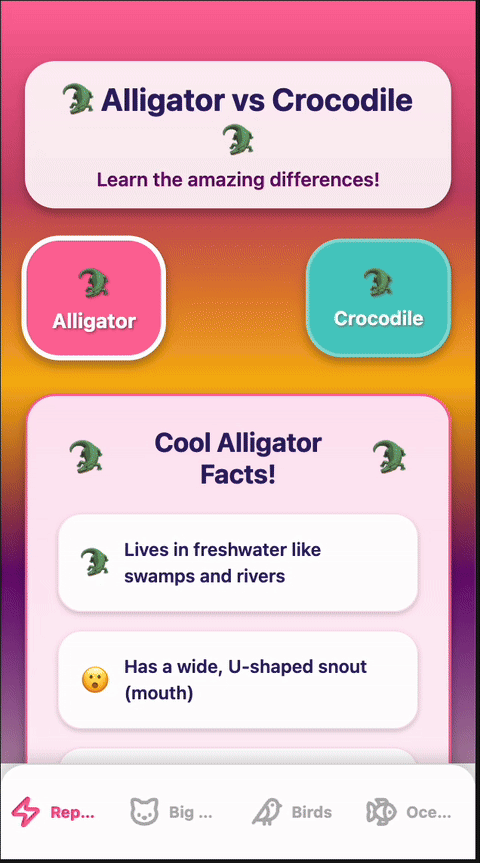How My 7-Year-Old Built an App in 12 Minutes
Why the leaders who embrace experimentation over intimidation will build the solutions their organizations desperately need
Yesterday, my 7-year-old did something that most Fortune 500 companies in the past decade paid developers five to six figures to accomplish. She built a working app, no coding knowledge, from scratch, in twelve minutes.
What used to cost $50,000 and six months of developer time now takes one conversation and a curious mind.
Last Tuesday, I sat with my daughter at our kitchen table, laptop open, asking her a simple question: "What kind of app would you want to build?"
Her eyes lit up. No hesitation. No "but I don't know how to code." Just excitement.
"Dad, can we make one that helps kids learn about animals?"
Minutes later, she had built a functional educational app using visual AI coding tools.
Visual AI coding means exactly what it sounds like: you describe what you want in plain English, and AI builds it. No programming languages. No technical syntax. Just a conversation turned into creation.
As I watched her ideas come to life instantly, I realized something profound: the obstacles that have separated leaders from technology are dissolving faster than we think.
The Conversation
Here's exactly what happened. I opened Bolt (a visual AI coding platform) and asked my daughter to describe her dream app. You can listen to our 30-second chat here…
Once she decided what she wanted to do, we went into Bolt.new and she dictated the following as her prompt.
I want to create an app that is for seven-year-old kids. It will be about the difference between an alligator and a crocodile and a lot of other animals. I'd like this app to be rainbow-colored and have a lot of other colors. I really like those, so I think this is a really good choice for an app.
That's it!
Bolt took her words and generated a complete, functional educational app about animals. Rainbow colors included.
No code written. No developers hired. No months of planning.
Just a conversation turned into creation.
I'll be honest. Watching her succeed so effortlessly in an area where I'd always felt intimidated made me question a lot of what I thought I knew about technology and leadership.
Here's what I realized: if my daughter could create something meaningful with technology in minutes, what does that mean for every leader who's ever said "I'm not technical enough"?
The 3 C's of Leader-Led Innovation
What my daughter demonstrated isn't just about apps. It's a completely new approach to leadership and problem-solving that I call the 3 C's of Leader-Led Innovation:
Curiosity: Approach technology like a child, with questions instead of assumptions
Conversation: Describe what you need in plain language, not technical specifications
Creation: Build solutions yourself instead of waiting for others to translate your vision
This framework is changing how mission-driven leaders think about innovation. Instead of being dependent on technical teams to bring ideas to life, leaders can now prototype, test, and refine solutions directly.
What This Means for Every Leader
If you're leading a church, nonprofit, startup, or small business, you've probably faced this scenario:
You have an idea for a solution. Maybe it's an app to help your congregation stay connected, a tool for volunteers to coordinate schedules, or a simple system to track donor engagement.
But then reality hits. You think you need a technical team, months of development, and thousands of dollars… so the idea dies in a meeting room.
That roadblock just disappeared.
Visual AI coding platforms like Bolt, Cursor, and v0 are turning natural language into functional applications. You describe what you want, and the AI builds it.
The dividing lines between "technical" and "non-technical" leaders aren't just blurring. They're gone.
The "I'm Not Technical" Myth
I hear this constantly: "I'm not technical enough for this."
Let me ask you something. Can you:
Have a conversation about what you need?
Describe a problem clearly?
Explain how you'd like something to work?
Then you have every skill required for visual AI coding.
The learning curve isn't about mastering code. It's about mastering communication.
And as a leader, you're already doing that every day.
Your Specific Next Steps
Here's exactly how to start experimenting today:
Week 1: Pick one recurring problem your team faces. Something that requires manual coordination or communication.
Week 2: Spend 30 minutes describing your ideal solution to a visual AI coding tool ( Start with Bolt or Lovable). Don't worry about perfection.
Week 3: Test your prototype with one team member. Get feedback. Iterate.
Week 4: Share your learning with your leadership team. Start a conversation about what else might be possible.
The tools are ready. The obstacles are gone. The only question is whether you'll embrace experimentation or stick with dependence.
Copy-Paste Prompt for Visual AI Coding
Want to try this yourself? While you can just use regular conversation and dictate your wish to an app, if you prefer prompts, here is one to get you started:
💡 Copy-Paste Prompt:
I'm a leader working with [specific context]. I need to create a simple application that helps with [specific problem or need].
The app should:
[Primary function][Secondary features][User experience preferences][Visual/design preferences]
My target users are [audience description] and they need this to be [accessibility/simplicity requirements].
Build this as a functional web application that I can test and share immediately. Include clear navigation, responsive design, and make it intuitive for users who aren't tech-savvy.
Then, use Infinite Prompting. Generate 15 iterations that help me:
Refine the user experienceAdd useful features I might have missedOptimize for my specific audienceCreate variations for different use casesInclude feedback mechanisms for continuous improvement
Each iteration should build on the previous one and include practical implementation details that make the app more useful for real-world scenarios.
Format the output with clear sections, use emotionally intelligent language that connects with users, and ensure everything remains simple enough for non-technical team members to understand and use.
If You Only Remember This
Visual AI coding removes technical roadblocks between your ideas and their execution
Communication skills matter more than coding knowledge when building with AI
The 3 C's (Curiosity, Conversation, Creation) are your new innovation framework
Every leader can experiment with building their own solutions today
What Will You Create First?
The same curiosity my daughter brought to building her animal app is available to you right now.
What problem would you solve if you could build the solution in one conversation?





That’s so interesting. Congratulations and warm hugs to your daughter. 💓
Thank you for inspiring us with your daughter and the 3 Cs!